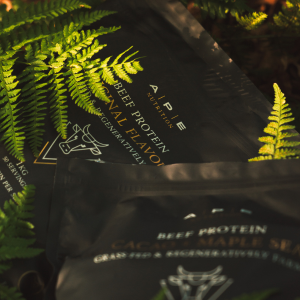Before I get into this I just want to say I don’t have anything against any type of diet.
It’s not my place to tell someone else what to do and I respect your dietary choices whatever they are. That said, I’ve been asked a version of this question so many times and I really think people could do with more awareness around the health complications that can arise from veganism and less so from vegatarianism.
Also, it’s important to be aware that health complications don’t arise overnight. Lots of people start out on these diets and might feel great for some time, especially if they’ve gone from eating a standard western diet filled with processed foods. However, when you starve your body of key micronutrients year after year, eventually you’re going to run into issues.
The Headline
Without intelligent supplementation, it’s impossible to get adequate micronutrients through a vegan diet. And even with a well-thought-through supplement plan, it still might not be possible for certain individuals depending on genetic makeup. For example, if you have the MTHFR gene (around 40% of people do), this will mean you require more vitamin B12, folate, glycine and choline to carry out methylation. This is a ‘first-line essential biochemical process’* within the body, which plays a critical role in the modification of DNA and when dysregulated contributes to diseases.’ Therefore if you’re planning on following a vegan diet, I highly recommend you have your DNA tested to see if you have this genetic mutation. On this, you may want to do some research into which companies don’t share your genetic data… this is something I wish I did before having my gene’s analysed.
This isn’t the case for vegetarian diets, as long as they contain fish, eggs and dairy regularly. However, pulling this off does require a fair bit of diligence. Beyond eating a few eggs per day, lot’s of grass-fed and full fat dairy and plenty of fish, you still need to consider how to get glycine into your diet. This can be achieved through fish skin, sesame seeds and spirulina but you’d need a lot.
The reality is, eating meat makes nourishing your body a lot simpler and it’ll become really clear why below when I start diving into individual nutrients and the best food source of them.
Whatever diet you’re following, it’s a really good exercise to download the app or go onto the website of Chronometer.* For free, you can input what you eat and it will tell you if you’re achieve the Recommend Daily Allowance (RDA) of all of the key micronutrients. Then based on anything you’re lacking in, you can do some research to find out what foods contain these nutrients in high amounts and add them into your diet.
There’s two things to note on this:
- The RDA is often jokingly referred to as the Recommended Deficiency Allowance because it’s set at the level to prevent dysfunction or disease. For example, the Vitamin C recommendation is based on what prevents scurvy, not what enables your body to function optimally. If you’re eating real foods, you don’t really need to worry about overdoing it on micronutrients. This is especially true for water-soluble vitamins (all the b vitamins and vitamin C) as you’ll excrete out any excess you don’t need.
- Although on paper plant foods may look like they’re great sources of certain nutrients, this isn’t always the case. This is because plant foods also contain defence chemicals known as anti-nutrients that block nutrient absorption. For example, heme iron (found in animal foods) has a bioavailability or absorption rate of 15-40%. Whereas non-heme iron (found in plant foods), has a bioavailability of 1-15%. Therefore although something like spinach may look like it has a lot of iron, in reality you can’t absorb much of it. Chronometer doesn’t take bioavailability into account and I’ve not come across any tracking software so far that does. This is another reason why it’s a safer bet and a lot less complicated to get your micronutrients from animal foods.
A Bit More on Anti-Nutrients…
Anti-nutrients are defence chemicals found in plants and come in three main forms:
🥜 Phytic acid // found in whole grains, legumes, lentils and nuts - this compound can lower our ability to absorb key minerals such as; magnesium, non-heme iron and calcium.
🍅 Lectins // found in beans, wheat (e.g. gluten) and vegetables like tomatoes and potatoes - this compound can interfere with nutrient digestion and absorption, shift bacterial flora and modulate the immune state of our digestive tract. Also, it can disrupt lipid, carbohydrate and protein metabolism.
🥬 Oxalates // found in vegetables like spinach, swiss chard, kale and celery - this compound can trap heavy metals in the body, create inflammation / kidney stones and stop the absorption of certain minerals like magnesium.
It’s thought that plants developed these defence mechanisms because they don’t want to be eaten. This is in contrast to fruits, that actually want to be consumed as their seeds mostly remain intact and are then spread through defecation. Also, just preempting this in the comments, I know animals don’t want to be eaten either, but they do have a a couple of instinctual defence mechanisms; running or fighting. And it’s well documented that their meat is highly nutritious and doesn’t contain defence chemicals.
I’m not saying you need to cut out all foods that contain anti-nutrients from your diet at all. In healthy individuals, and when eaten in small to moderate amounts these don’t have any noticeable impact. And these foods (when organic) have health benefits that in my opinion outweigh any negative impact anti-nutrients might have. However, if you’re experiencing issues with your gut, digestion, inflammation or have an autoimmune disorder, it’s definitely worth systematically cutting these out one by one and seeing if it makes a difference. The exception to this is wheat that has no health benefits and often contains high amounts of gluten, which is common issue for people.
Also, fermentation, soaking and cooking foods, which were common preparation methods for our ancestors, can drastically reduce their anti-nutrient content. For example, cooking spinach has been shown to decrease its oxalate levels by half.
Other Reasons Why The Nutrients From Plant Foods Are Less Absorbable
Beyond the presence of anti-nutrients and genetics, there’s a couple more reasons why the nutrients in plant foods can be less absorbable:
- Gut issues such as parasites and bacterial overgrowth can damage intestinal mucosal cells and result in increased permeability and decreased absorption of nutrients.
- Having good levels of stomach acid helps with the absorption of micronutrients. If you don’t eat protein, stomach acid levels are likely to be impaired.
The Nutrients Lacking or Missing on a Vegan and Vegetarian Diet
OK so enough pre-text, let's get into it... there are 8 key micronutrients commonly lacking in people following these dietary approaches; Vitamin A, B12, Choline, DHA, Glycine, Iron, Vitamin K2 and Zinc. Below I cover what these nutrients are, the RDA (if there is one), the beneficial roles they play in the body and the top food sources of each.
Vitamin A
Vitamin A comes in two forms; retinol, the version found in animal foods that our body can readily use and beta-carotene the plant version (commonly found in orange vegetables like carrots and sweet potato) that our bodies need to convert to retinol to use. The bioavailability (how much we can actually use) of retinol is 80%, whereas the bioavailability of beta-carotene ranges between 5-65%.
One of the reasons for beta-carotene being less absorbable is the BCM01 gene (found in 32-69% of UK women), which was shown to reduce the conversation of beta-carotene to retinol. Another reason is that we require riboflavin, niacin, iron and zinc to convert beta-carotene to retinol. As you’ll see below both iron and zinc can easily be lacking on a vegan or vegetarian diet.
The RDA for Vitamin A is 900ug (men) and 700ug (women) of retinol.
Benefits of Vitamin A:
- Promotes healthy vision (so carrots may actually help you see better in the dark - as long as you don’t have the BCM01 gene, gut issues or low stomach acid)
- Aids sleep
- Protects against kidney stones, autoimmune diseases, asthma, allergies and food intolerances
- Helps make hormones like testosterone and oestrogen.
*All information discussing the benefits of specific nutrients in this article has been adapted from Dr. Chris Masterjohn’s book; Vitamins and Minerals 101.
Top Sources of Vitamin A:
1.) Beef liver // 100 grams contains 7,730 mcg of retinol (859% of the RDA)
2.) Cod Liver Oil // 1 tablespoon (14 g) contains 4,080 mcg of retinol (453% of the RDA) Cod Liver Oil can easily go rancid so it’s important to get it from a reputable brand. My favourite is Rosita.
2.) Cod Liver Oil // 1 tablespoon (14 g) contains 4,080 mcg of retinol (453% of the RDA) Cod Liver Oil can easily go rancid so it’s important to get it from a reputable brand. My favourite is Rosita.
3.) Grass-fed butter // 1 tbsp (14 g) contains 95 mcg of retinol (11% of the RDA)
4.) Wild-caught Salmon // 100 grams contains 69 mcg of retinol (8% of the RDA)
5.) Eggs // One large (50 g) hard-boiled egg contains 75 mcg of retinol (8% of the RDA)
4.) Wild-caught Salmon // 100 grams contains 69 mcg of retinol (8% of the RDA)
5.) Eggs // One large (50 g) hard-boiled egg contains 75 mcg of retinol (8% of the RDA)
Vitamin B12
Vitamin B12 is almost exclusively found in animal foods, although it has been found in small amounts in some vegetables and algae. That said, you’d have to eat a huge amount of these foods to reach the RDA and even then there’s no evidence that this would stop B12 deficiency. Therefore it’s best to focus on getting your B12 from animal foods or if this isn’t an option, you’ll need a supplement. If you are going to supplement, the best form is Hydroxycoblamin.
The RDA for Vitamin B12 is 2.4ug for both men and women.
Benefits of Vitamin B12:
- Vital for supporting methylation, the importance of which was covered above under the headline section
- Helps prevent anaemia and nervous system degeneration
Top Sources of Vitamin B12:
1.) Organ Meat // 100 grams of beef liver contains up to 3,571% of the RDA for vitamin B12, while the same serving of kidneys contains up to 3,000% of the RDA
2.) Oysters // We use roughly 18 grams of raw oysters to create one serving (4 capsules) of our Celtic Oysters product. Just 4 capsules contains 1.5ug of Vitamin B12, which is 58% of the daily recommended intake.
3.) Beef // One grilled flat iron steak (about 190 grams) provides 467% of the RDA for vitamin B12
4.) Eggs // Two large eggs (100 grams) supply about 46% of the RDA for vitamin B12
2.) Oysters // We use roughly 18 grams of raw oysters to create one serving (4 capsules) of our Celtic Oysters product. Just 4 capsules contains 1.5ug of Vitamin B12, which is 58% of the daily recommended intake.
3.) Beef // One grilled flat iron steak (about 190 grams) provides 467% of the RDA for vitamin B12
4.) Eggs // Two large eggs (100 grams) supply about 46% of the RDA for vitamin B12
*If you’re vegatarian or vegan due to not wanting animals to suffer. You may want to reconsider eating oysters. They don’t have a central nervous system so it’s thought they don’t feel pain. They are one of the best sources of Vitamin B12, as well as Zinc and DHA (covered below).
Choline
The two best sources of Choline are egg yolks and beef liver. One egg contains 115mg of Choline, whereas 28 grams of beef liver contains 119mg. Plant foods do contain some Choline, however in much smaller amounts. For example, half a cup of broccoli or quinoa provides 30 and 20mgs of Choline respectively.
There’s no RDA for Choline, but there is an Adequate Intake (AI) level, which is set at 425mg for women and 550mg for men.
Benefits of Choline:
- Supports brain health
- Protects again fatty liver / aids in fat digestion
- Supports methylation
- Enhances muscle strength
Top Sources of Choline:
1.) Eggs // One whole egg contains anywhere from 115-130mgs depending on the size.
2.) Beef Liver // 28 grams of Beef Liver (our Beef Liver capsules contain around 15 grams of raw liver) contains 119mg.
3.) Meat and Fish // A 250g portion of meat or fish will contain around the same amount of Choline as one egg.
4.) Nuts and Seeds // These do contain some Choline. However you’d need to eat A LOT to hit the AI. For example 200g of cashews or 500g of sesame seeds is roughly the same as eating an egg.
5.) Wheat Germ // This is the best vegan source of Choline with 145g equalling around 2 eggs.
2.) Beef Liver // 28 grams of Beef Liver (our Beef Liver capsules contain around 15 grams of raw liver) contains 119mg.
3.) Meat and Fish // A 250g portion of meat or fish will contain around the same amount of Choline as one egg.
4.) Nuts and Seeds // These do contain some Choline. However you’d need to eat A LOT to hit the AI. For example 200g of cashews or 500g of sesame seeds is roughly the same as eating an egg.
5.) Wheat Germ // This is the best vegan source of Choline with 145g equalling around 2 eggs.
Next month I'll cover the remaining 5 micronutrients in part two, as well as outlining a day of eating to replenish the nutrient levels within the body as quickly as possible post veganism.
DHA
DHA is an Omega-3 fatty acid, which is really important for neurological function. It’s mainly found in fish, liver and egg yolks. However, there is another version of Omega-3 called ALA that is found in plant oils and can be converted within the body to DHA. But and this is a big BUT, the conversation rate is, at best, 3.8%. To make this even worse, when diets are high in Omega-6 fats (found in vegetable oils, nuts and seeds - all common on a vegan / vegetarian diet), this conversion rate drops to 1.9%.
There’s no RDA for DHA, however most mainstream health organisations suggest trying to obtain 250-500mg of Omega-3 (DHA & EPA combined) daily. Chris Masterjohn, an expert in micronutrients, recommends that most adults should aim for 150mg of DHA per day.
Benefits of DHA:
- Essential for the maintenance of normal brain function. It’s been associated with improvements in all sorts of neurodivergence; ADHD, autism, memory loss and depression.
- It’s extremely important for infants and foetus’ within a mothers womb as it helps the brain develop.
- Outside of the benefits it plays in relation to the brain, which it is most well known for, DHA helps to ‘resolve’ inflammation within the body. Basically this means it plays a role in the clear up process after we’ve had an inflammatory response, for example after an infection.
- DHA lowers blood triglycerides, which protects against cardiovascular issues.
- It helps protein bind wherever it’s needed within the body so it can create cells, build muscle, etc.
- Finally it plays a role in visual acuity, helping us see final details clearly.
Top Sources of DHA:
1.)Wild Caught Fish & Shellfish // salmon, mackerel, sardines and oysters are all great sources of DHA. For example salmon contains 2,150mg of combined EPA and DHA in just 100 grams. Therefore one 200g portion per week will cover your requirements easily.
2.) Pasture Raised Eggs // the levels of DHA in egg yolks can vary significantly depending on the quality. However, I’ve seen information showing anywhere from around 7-30mg per egg yolk. Therefore if you’re getting really high quality eggs there’s potential for you to cover your DHA requirements with 5 per day. It’s important the eggs are from chickens that have been farmed properly, spending as much time outdoors as weather conditions allow and eating a natural diet of worms etc to ensure good amounts of DHA are present in the eggs. Interestingly grass-fed beef has also been shown to have a lot better Omega 3:6 levels than the beef from cows that have been fed an unnatural diet of corn, soy, etc.
3.) Cod Liver Oil // just one teaspoon of Cod Liver Oil contains 605mg of DHA. It’s also a great source of EPA, Vitamin A (Retinol) and Vitamin D. As with all supplements (and food) you want to make sure the quality is really high so the nutrients you expect to be there are actually present. The Brand I recommend for Cod Liver Oil is Rosita.
4.) For vegans to get adequate DHA, supplementation is required and the best form as far as I’m aware is algae oil.
Glycine
Glycine is the most abundant amino acid in Collagen, which is the main form of protein within the body (it makes up roughly 30% of total body protein). It gives structure to our tendons, ligaments, bones, skin, hair, nails and the gut lining. It's also been associated with longevity benefits (due to balancing out the amino acid profile within the body) and improved sleep. This is one of the nutrients that is especially hard to find on a vegetarian or vegan diet. The best vegan friendly source (as far as I’m aware) is sesame seed powder, which contains roughly 1550mg per 50 grams. Therefore you’d have to eat 325 grams of this a day to hit the recommended amount.
There’s no RDA for glycine but research has suggested people should aim for around 10 grams per day.
Benefits of Glycine:
- As stated above it’s the main amino acid in Collagen, which has a wide variety of structural benefits.
- Studies suggest it may improve sleep quality through having a calming effect on the brain.
- Animal studies have shown that when methionine (an amino acid abundant in muscle meat) is balanced with glycine, this has longevity benefits and improves lifespan. Although there needs to be more research done in human models, looking at this through the lens of evolutionary biology, it makes sense. Traditional cultures would have eaten the whole animal nose-to-tail, which would have included a lot of gelatinous cuts of meat and bone broth (both really high in glycine). Therefore our bodies have evolved and are designed to operate consuming large amounts of this amino acid.
- We use glycine to created glutathione within the body, a really powerful antioxidant, which helps us combat oxidative stress.
- Glycine also plays a key role in creating creatine within the body, an important nutrient for exercise performance and brain function.
Top Sources of Glycine:
1.) Gelatine and Collagen Powders // these are the most concentrated sources of Glycine. In just 10grams of our Collagen powder, you’ll get 2.6 grams of glycine.
2.) Bone Broth // One cup (250mg) provides roughly 1.7 grams.
3.) Beef Mince // 200 grams contains about 3.6 grams of glycine.
4.) Gelatinous cuts of Meat like Lamb Shoulder // 200 grams contains around 3.4 grams of glycine.
5.) Spirulina Powder // This is the second best options for vegans with half a cup containing roughly 1.76 grams.
Iron
This mineral is difficult to obtain when not eating meat due to it being poorly absorbed from plants. Plant foods contain non-heme iron, which has been shown to have a bioavailability (absorption rate) of 2-13%. Whereas heme-iron found in animal foods has a bioavailability of 15-40%. This is because plant foods which contain iron also generally contain physic acid, an anti-nutrient discussed in detail previously, which blocks its absorption.
The RDA for iron is 16-18mg per day for men and 12mg per day for women. For vegetarians it’s recommended that they aim for 1.8 times higher than this so 28.8-32.4 and 21.6mg respectively.
Benefits of Iron:
- Getting adequate iron into your diet prevents anaemia, a condition where your blood doesn’t carry enough oxygen to your tissues and as a result people tend to feel weak, tired and depressed.
- Iron is required to make thyroid hormone so not getting enough can lead to hypothyroidism (underachieve thyroid). Again this is associated with fatigue, weakness and depression and as a result can cause weight gain, hair loss and fertility issues.
- Too little iron can cause oxidative stress, however this can also be caused by iron overload. Therefore you need to also be careful to not consume too much (in some cases). Our bodies can naturally regulate iron, meaning we can increase the amount we absorb from food if we’re low or decrease it if we have too much. However unfortunately there’s a gene mutation called HFE, which causes iron absorption to be ramped up all the time. It’s thought this developed when we switched from a Hunter Gatherer diet high in heme-iron to an iron poor agricultural grain based diet. If you have this gene it’s important to make sure you’re not over consuming iron and you can also give blood to release excess iron stores.
Top Sources of Iron:
1.) Spleen // beef spleen is the highest food source of iron with 100 grams containing 44.6mg’s. So just over 25 grams would hit the RDA for women and around 40 grams would hit the RDA for men.
2.) Liver // 100 grams of beef liver contains around 6.5mg of iron.
3.) Shellfish // clams, oysters and muscles are all really good sources of iron, with one raw oyster contains around 5mg's.
4.) Red Meat // all cuts of beef, lamb, pork, venison and goat contain good amounts of iron. For example a 100 gram serving of minced beef contains around 2.7mg's.
5.) Spinach // The best vegan and vegetarian source of iron, spinach contains around 2.7mg's per 100 grams when raw. However, as explained above, this is the non-heme version of iron so won’t be absorbed as well.
Next month I’ll add the final two nutrients; Vitamin K and Zinc as well as giving an example of what I eat in a day to cover all my micronutrient bases.
Vitamin K
Vitamin K comes in two forms K1 (the plant version) and K2 (the animal food version). Unlike other nutrients where you need to convert the plant version into the animal version within the body for it to become useable. Vitamin K1 and K2 actually serve different functions. K1’s main role is to help with blood clotting. Whereas K2 ensures that calcium accumulates in your bones as apposed to your soft tissue, where it can cause issues. Note, this is another reason why I don’t recommend synthetic calcium supplements; because they just contain calcium without K2. Whenever we consume calcium in nature, it always comes paired with K2 within the food to ensure the calcium travels to the right place within our bodies to support bone health. As you can see from the top sources below, all but Beef Liver are vegetarian friendly, so if you eat enough dairy, eggs and Natto you should be able to cover your Vitamin K2 requirements as a vegetarian. However, it’s much harder as a vegan and impossible for strict vegans as Natto is fermented using bacteria and therefore off limits.
There’s no RDA for Vitamin K but research suggests that we should aim to consume at least 100mcg of K2 per day.
Benefits of Vitamin K2:
✅ Essential for proper bone mineralisation.
✅ Prevents calcium from going to the wrong places within the body e.g. the kidneys (can cause kidney stones) and the blood vessels (can cause heart disease).
✅ Aids in the production of insulin, a hormone that helps with blood sugar stabilisation.
✅ Plays a role in optimising sex hormones in both men and women.
Top Sources of Vitamin K2:
🌱 Natto (fermented soybean) // this is the most concentrated source of K2 with one 10g serving covering your daily requirement, providing roughly 110mcg of Vitamin K2.
🥚 Eggs // depending on the quality, eggs have been shown to contain anywhere between 67 and 192 mcg’s of K2 per yolk.
🧀 Hard Cheese (E.g. Parmesan, Cheddar, Gouda) // one 50g serving of Gouda contains around 30mcg of K2.
🐄 Beef Liver // this is the best meat source of K2, with a 100g serving containing around 10mcg.
🥛 Full Fat Dairy // one tablespoon (10g of butter) contains 2.1 mcg’s of K2.
Zinc
Although there are a lot of plant foods that contain zinc (legumes, whole grains, nuts and seeds), these often also contain anti-nutrient like physic acid, which block zinc absorption. To account for this, the Zinc RDA for vegetarians is set at 50% higher than for meat eaters. However, some research suggests this still isn’t enough to prevent Zinc deficiency.
The RDA for Zinc is 8mg per day for women and 11mg per day for men. For vegetarians this increases to 12mg and 16.5mg respectively.
Benefits of Zinc:
✅ Boosts immune function through influencing the signalling pathway of immune cells and is used to create white blood cells that carry immune boosting compounds around the body.
✅ Plays a key role in skin health through enabling collagen synthesis and has been associated with accelerated wound healing, a reduction in acne and the prevention of sagging skin.
✅ Helps in the creation of sex hormones in both men and women.
Top Sources of Vitamin Zinc:
🦪 Oysters // just six medium size oysters provide triple the RDA for men at 33mg.
🥩 Red meat // 100g of mince beef contains just under 5mg of Zinc.
🥛 Dairy // one cup (250g) of milk contains around 10% of the RDA.
🥚 Eggs // one large egg covers 5% of the RDA for men and 7% for women.
Summary
This is probably the most requested article I’ve been asked to write so I really hope it’s hit the mark. If I’ve missed anything or you have any questions, please feel free to send them via our contact form or direct message us on Instagram.
My personal take on this information is that for the vast majority of humans, animal foods are necessary not just to function optimally, but for a baseline level of health from a nutritional standpoint. And although I’m not against any type of diet, I think it’s really important to understand the nutritional approach you’re adopting and the potential risks involved.
Nutrition can be a really complicated topic but at the same time it’s so simple… Nature inherently has us covered, so if you just eat local, seasonal foods that are organic (for plant foods) and (grass-fed / free-range / wild-caught) for animal foods you’ll more than cover your micronutrient requirements without having to think about them. However that’s a lot easier said than done in the modern world where supermarkets shelves are lined with nutrient void convenient foods. That’s why it’s so important to find your local farmers market and make a habit of going there every week… do this and it’s hard to go wrong.
Here's To More Life,
Josh






